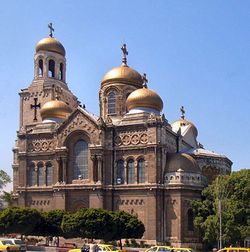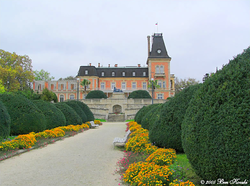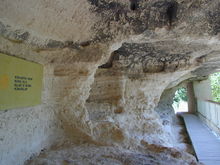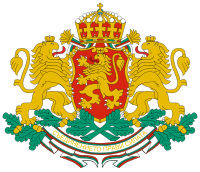Varna Province
| Varna Province Област Варна |
|
|---|---|
| — Province — | |
 |
|
| Country | |
| Capital | Varna |
| Municipalities | 12 |
| Government | |
| - Governor | Doncho Simeonov |
| Area | |
| - Total | 3,820 km2 (1,474.9 sq mi) |
| Population | |
| - Total | 500,428 |
| - Density | 131/km2 (339.3/sq mi) |
| Time zone | EET (UTC+2) |
| - Summer (DST) | EEST (UTC+3) |
| License plate | B |
| Website | vn.government.bg |






.jpg)
Varna Province (Bulgarian: Област Варна, Oblast Varna) is a province in northeastern Bulgaria, onе of the 28 Bulgarian provinces. It comprises 12 municipalities (общини, obshtini, sing. общинa, obshtina); its administrative centre is Varna.
Contents |
Geography
The province's territory is 3,820 square kilometres. It borders the Black Sea and covers parts of the hilly Danubian Plain (including parts of the Franga Plateau, South Dobruja, the Provadiya Plateau, Ludogorie, and the Avren Plateau), Eastern Stara Planina, the Varna—Devnya valley with the lakes (limans) of Varna and Beloslav, and the Kamchiya river valley. Other rivers include Provadiya, Devnya, and Batova, and the largest artificial lake is Tsonevo.
The Black Sea coast is hilly and verdant, mostly cliff, with a couple of rocky headlands (Cape Galata, Cape St. Athanasius), several expansive sand beaches, the largest of which, at the mouths of the rivers Kamchiya and Shkorpilovska, is nearly 13 km long and up to 200-300 m wide, and many small cove beaches. Agricultural lands cover 60% of the area, with fertile chernozem soils mostly in the north and west; forests—28.1% (with some of the oldest oak massives in the nation), mostly in the south; and urban zones—6.8%.
Natural resources include large deposits of rock salt, limestone, silica, and clays, all extensively utilized in local chemical, cement and glass manufacturing and construction; silica is also exported. Significant deposits of medicinal fango (mineral mud) are found in Lake Varna. The province abounds in thermal mineral waters. There are also natural gas reserves; the offshore Galata gas field, a relatively minor project with planned cumulative production of 2 billion cubic meters, is expected to provide up to 15% ot the nation's gas consumption for its lifetime. Manganese ore deposits are also found.
The climate inland is temperate, with cold, damp winters and hot, dry summers, and akin to Mediterranean along the Black Sea coast, with milder winters and cooler summers.
Municipalities
- Aksakovo (including the town of Aksakovo and the villages of Botevo, Dobrogled, Dolishte, Ignatievo, General Kantardzhievo, Izvorsko, Kichevo, Klimentovo, Krumovo, Kumanovo, Lyuben Karavelovo, Novakovo, Oreshak, Osenovo, Pripek, Radevo, Slanchevo, Voditsa, Vaglen, Yarebichna, Zasmyano, and Zornitsa)
- Avren (including the villages of Avren, Benkovski, Bliznatsi, Bolyartsi, Dobri Dol, Dabravino, Kazashka Reka, Kitka, Krusha, Priseltsi, Ravna gora, Sadovo, Sindel, Trastikovo, Tsarevtsi, Yunak, and Zdravets)
- Beloslav (including the town of Beloslav and the villages of Ezerovo, Strashimirovo, and Razdelna)
- Byala (including the town of Byala and the villages of Dyulino, Goritsa, Gospodinovo, Popovich, and Samotino)
- Dalgopol (including the town of Dalgopol and the villages of Arkovna, Asparuhovo, Boryana, Kamen Dyal, Komunari, Krasimir, Lopushna, Medovets, Partizani, Polyatsite, Royak, Sava, Sladka Voda, Tsonevo, and Velichkovo)
- Devnya (including the town of Devnya and the villages of Kipra and Padina)
- Dolni Chiflik (including the town of Dolni Chiflik and the villages of Bardarevo, Bulair, Detelina, Golitsa, Goren Chiflik, Grozdyovo, Krivini, Nova Shipka, Novo Oryahovo, Pchelnik, Rudnik, Solnik, Staro Oryahovo, Shkorpilovtsi, Venelin, and Yunets)
- Provadiya (including the town of Provadiya and the villages of Barzitsa, Blaskovo, Bozveliysko, Chayka, Cherkovna, Chernook, Dobrina, Gradinarovo, Hrabrovo, Kiten, Komarevo, Krivnya, Manastir, Nenovo, Ovchaga, Petrov Dol, Ravna, Slaveykovo, Snezhina, Staroselets, Tutrakantsi, Venchan, Zhitnitsa, and Zlatina)
- Suvorovo (including the town of Suvorovo and the villages of Banovo, Chernevo, Drandar, Izgrev, Kalimantsi, Levski, Nikolaevka, and Prosechen)
- Valchidol (including the town of Valchidol and the villages of Boyana, Brestak, Cherventsi, Dobrotich, Esenitsa, General Kiselovo, General Kolevo, Iskar, Izvornik, Kaloyan, Karamanite, Krakra, Metlichina, Mihalich, Oborishte, Radan Voyvoda, Shtipsko, Stefan Karadzha, Strahil, Voyvodino, and Zvanets)
- Varna (including the city of Varna and the suburban villages of Kamenar, Kazashko, Konstantinovo, Topoli, and Zvezditsa)
- Vetrino (including the villages of Belogradets, Dobroplodno, Gabarnitsa, Mlada Gvardiya, Momchilovo, Nevsha, Neofit Rilski, Sredno Selo, Vetrino, and Yagnilo)
Population
The population of the province is 500,428[1] (2009). 71% live in Varna, and 81% in urban areas (national average 70%). Population density (130 per km²) is significantly higher than the national average (70); the birth, marriage, and divorce rates are also higher; the death rate and the unemployment rate (7.34%, 2005) are lower. 71,1% of the population are in working age; above working age are 14.8%.
The ethnic composition includes Bulgarians—85.3%; Turks—8.1%; Roma—3.4% (there are a few mostly Roma-populated villages such as Lyuben Karavelovo in Aksakovo municipality—inhabited by Vlach Gypsies of the Kopanari subgroup); Armenians—0.6%; Russians—0.3% (including about 340 Cossacks in the Lipovan village of Kazashko); and smaller numbers of Ukrainians, Jews, Greeks, Crimean Tatars, Circassians, Vlachs, and others. There is a growing number of western expatriates and new Chinese, Indian, Arab, African, and other immigrants.
The province was a centre of the Bulgarian Turks' human rights movement in the 1980s resisting the assimilation campaign of Todor Zhivkov's communist government. The Drandar group (named after the village of Drandar, municipality of Suvorovo, where politician Ahmed Dogan was also raised) is considered the germ of the Movement for Rights and Freedoms.
Several rural villages in the municipalities of Aksakovo, Suvorovo, and Valchidol, as well as the Vinitsa district of Varna, have historically been populated mostly by Gagauz, who for the most part now identify themselves as Bulgarians.
Religious groups include Orthodox Christians—83%; Muslims—9.75%; smaller groups of Protestants, Roman Catholics, Jews, Buddhists, members of new religious movements, and others. Varna was the initial centre of Peter Deunov's Esoteric Christianity. Deunov himself was born (1864) in Nikolaevka, municipality of Suvorovo.
History
The area has been populated at least since the Neolith and was a major centre of an Eneolithic culture with unique skills in metallurgy and seafaring, with a developed social structure and religion (see Varna Necropolis, site of arguably the oldest man-made gold treasure in the world).
By the first millennium BC, is was inhabited by Thracians who dominated it throughout classical antiquity; by the end of the period they were largely Romanized. In the 6th century BC, an ancient Greek trading colony (apoikia), Odessos (Varna), was founded, becoming an enduring contact zone between Thracians and Greeks. In the 4th century, the province was included in the empire of Philip II, Alexander the Great and his diadochus Lysimachus.
By the first century AD, it was conquered by the Roman Empire. Under Emperor Diocletian, Marcianopolis (Devnya) became the centre of the Roman province of Moesia Secunda of the Diocese of Thrace; during Emperor Valens' wars with the Goths (366-369), this city was temporary capital of the empire. Both Marcianopolis and Odessus (the Roman name of Odessos) were major early Christian centres; it is believed that Saint Andrew founded the local Christian church and his disciple Ampliatus served as bishop at Odessus.
In the 6th century, Slavs' migrations altered the ethnic composition of the then Byzantine province, and in 680-681 it became the heartland of the First Bulgarian Empire, whose capital was perhaps initially near Varna, before it moved to Pliska. Two of the most significant scriptoria of the Preslav Literary School were located at Ravna (near Provadiya) and Varna.
The latter two cities were major fortresses and trade emporia of the Second Bulgarian Empire as well. The peasant war of Ivailo in the late 13th century started from the region, which at the time was plagued by Tatar raids and was finally subdued by the Ottomans in 1389. In 1444, the Battle of Varna was fought, as were several ground and naval battles of the Russo-Turkish wars of the 18th and 19th century.
Under the Ottomans, the population became extremely diverse, with significant number of Turks and other Muslim peoples arriving from Asia Minor, the steppes north of the Black Sea, and the Caucasus, along with Orthodox Christian Gagauz, Armenians, and Sephardic Jews from Thessaloniki, while many Bulgarians from the region were forcibly relocated to Asia Minor and, in the wake of the Russo-Turkish wars, up to 250,000 eastern Bulgarians were transferred to Russian Bessarabia and Crimea.
Compact Bulgarian population persisted throughout the Provadiya Plateau, Devnya Valley, and Eastern Stara Planina. Villagers from places such as Chenge (modern Asparuhovo, municipality of Dalgopol), Gulitsa (modern Golitsa, municipality of Dolni Chiflik), and neighbouring Erkech (modern Kozichino, Burgas Province) later colonized and returned the Bulgarian ethnic character to dozens of villages throughout northeastern and southeastern Bulgaria, including much of Varna province.
After the liberation of 1878, with the exodus of most Turks and Greeks and the migrations of Bulgarians from other parts of Bulgaria, mostly Stara Planina, as well as North Dobruja, Asia Minor, Bessarabia, and later from Macedonia and Eastern Thrace, ethnic diversity gradually gave way to Bulgarian predominance.
Economy
The province in currently second only to Sofia in foreign direct investment; its GDP per capita is higher and its unemployment is the lowest in the country. Per capita income is fifth highest in the nation (2007). The economy is service-oriented; it is responsible for over 30% ot the nation's total revenue in tourism (2004). (See also the list of coastal resorts, beaches and locales below.)
It is also an important communications and transportation hub with the Port of Varna on the Black Sea and inland waterways, the International Airport of Varna, the Varna railway ferry terminal, parts of several railway lines (including the oldest one in Bulgaria, Rousse-Varna, opened 1866) and junctions (Sindel, Razdelna, Komunari), and portions of two of the nation's motorways (Haemus and Cherno More). Varna is the easternmost destination of Pan-European transport corridor 8 and is closely connected to corridors 7 and 9 via Rousse.
In June 2007, Eni and Gazprom disclosed the South Stream project whereby a 900 km-long offshore natural gas pipeline from Russia's Dzhubga with annual capacity of 30 billion cubic meters is planned to come ashore possibly at Pasha dere, near the Galata offshore gas field, en route to Italy and Austria.
Manufacturing is concentrated mostly in the Varna-Devnya Industrial Complex and Provadiya. Agriculture (notably wheat, fruit, wineries) and forestry are also of economic significance. The province is a major education and international culture centre with five universities, several other higher learning and research institutions, numerous museums, performing arts institutions, and hosted international events.
Real estate has been booming over the last few years not only in Varna but in rural villages both near the coast and inland. "English villages" of Britons settling in Bulgaria emerged in the rural countryside at Avren, Banovo (municipality of Suvorovo), and General Kantardzhievo (municipality of Aksakovo), among others.
Sights
Varna is Bulgaria's third largest city, after Sofia and Plovdiv. The oldest gold (dated 4200 - 4600 BC) in the world was found near the city. It was an inhabited place long before the Greeks established the colony of Odessos there about 580 B.C. Later, under the Romans and their successors, the Slavs and Bulgarians, Varna became a major port trading with Constantinople, Venice and Dubrovnik. In 1393 it was captured by the Turks, who made it an important military centre. Nowadays it is the nation's main port for both naval and commercial shipping and, adjacent as it is to the coastal resorts of Constantine and Helena, Riviera, Golden Sands, and Kamchia. Sailors on shore-leave in unfamiliar ceremonial uniforms, mingle with foreign tourists and locals as they promenade along shady boulevards, lined by dignified 19th and early 20th century buildings. The 19th century Dormition of the Theotokos Cathedral is an imposing landmark, which contains a finely carved iconostasis and bishop's throne, some interesting murals and stained glass. The 2nd century Thermae are the remains of the largest Roman public building in Bulgaria. During this century enough has been revealed by archaeologists to give a good impression of the original layout, though some parts of the building remain hidden under nearby streets. Coming across an extensive ancient building amidst the streets and houses of a modern city is not unusual in Bulgaria, but is always a delight. Further from the centre, a monument commemorates the Battle of Varna, which took place in 1444. Here 30,000 Crusaders were waiting to sail to Constantinople when they were attacked by 120,000 Turks. The Polish King Ladislaus III was killed in a bold attempt to capture Sultan Murad II. The subsequent retreat foreshadowed Christendom's general retreat before the advancing Ottomans. North of Varna there is a cluster of seaside resorts all with fine sandy beaches but differing in size and style.
Some other places of interest include (by municipality):
- Avren: observatory, Petrich fortress, cave monastery, museum of ethnography in Tsarevtsi
- Aksakovo: Batova chalet park near Dolishte, St. Marina monastery near Krumovo
- Dolni chiflik: museum of ethnography, Sherba state hunting farm (ДДС Шерба) and chalet
- Dalgopol: museum of history, Ovchaga ethnographical village in Asparuhovo, ecopark Vodenitsite in Sladka Voda
- Provadiya: Lambova kashta ethnographical complex, Ovech fortress, ethnographical collections in Dobrina and Manastir
- Suvorovo: museum of history, mosque, Peter Deunov house museum in Nikolaevka
- Valchidol: ski run
See also: Byala, Devnya, Provadiya
Environment
Environment in Varna Province is subject to strict national and international protection, due to its vulnerability and international significance.
Reserves
- Kamchiya Biosphere Reserve (UNESCO-listed) (Dolni Chiflik, Avren)
- Valchi prehod (Dolni Chiflik)
- Kirov dol (Dolni Chiflik)
- Varbov dol (Dalgopol)
- Kalfata (Dalgopol)
National parks
- Golden Sands Nature Park (Varna, Aksakovo, Balchik (Dobrich Province))
Protected areas
- Rakitnika (Varna)
- Petricha (Beloslav)
- Slaveikova gora (Provadiya)
- Yatata (Beloslav)
- Tulumova peshtera (Dalgopol)
- Vodenitsite (Dalgopol)
- Aladzha Monastery (Varna)
- Snezhinska koriya (Provadiya)
- Vodenitsite (Dalgopol)
- Orlov kamak (Dolni Chiflik)
- Gorska baraka (Dolni Chiflik)
- Pobiti Kamani (Beloslav, Aksakovo)
- Liman (Avren)
- Pregrada (Dalgopol)
- Kazashko (Varna)
- Golyamata kanara (Vetrino)
- Kamchiyski pyasatsi (Dolni Chiflik)
Nature landmarks
- Gorna i Dolna Kapladzha (Beloslav)
- Slyapoto kladenche (Beloslav)
- Byal oman (Dolni Chiflik)
- Urumovo lale (Suvorovo)
- Kuza skoka waterfall (Dalgopol)
- Sini vir waterfall (Dalgopol)
- Chudnite skali rock phenomenon (Dalgopol)
Coastal resorts, beaches, and locales
- Frenkliman
- Panorama
- Golden Sands
- Holiday Club Riviera
- Chaika
- Kabakum
- Sunny Day
- Constantine and Helena
- Euxinograd
- Varna
- Asparuhovo
- Galata
- Fichoza (Priboi)
- Chernomorets chalet
- Pasha dere
- Rodni balkani (formerly chalet, currently military base)
- Romantika
- Kamchia
- Kamchiyski pyasatsi
- Shkorpilovtsi
- Mecho uho
- Karadere
- Belite skali
- Byala
- Luna
See also
- Provinces of Bulgaria
- List of villages in Varna Province
References
External links
- District Administration Varna (Official site)
- Kamchia - photo gallery
- Bulgaria Travel Guide
- Pictures from Varna region
 |
Dobrich Province |  |
||
| Shumen Province | Black Sea | |||
| Burgas Province |
|
||||||||||||||
|
||||||||||||||||||||||||||
